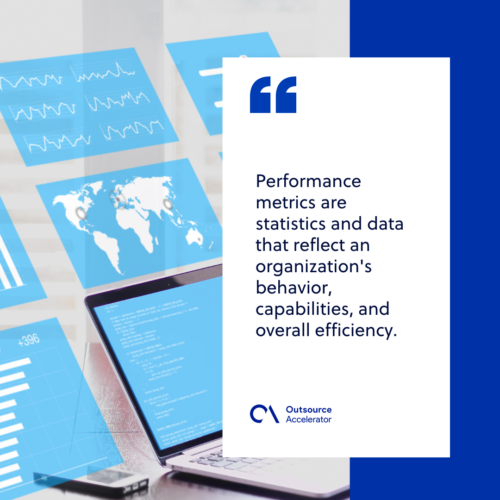Performance metrics
Definition
What are performance metrics?
Performance metrics are statistics and data that reflect an organization’s behavior, capabilities, and overall efficiency. Sales, benefits, return on investment, consumer satisfaction, customer feedback, personal reviews, overall quality, and credibility in a marketplace are examples of success indicators. When viewed through the lens of various industries, performance metrics can vary greatly.
Performance metrics are helpful to assess a company’s actions, operations, and overall performance. It can take the form of data that measures needed data within a range, leading to the formation of a foundation to affect overall business objectives. Measuring success with metrics is critical for determining how workers are doing and whether goals are doable.

Different types of performance metrics in call centers
Every business aspires to be more successful. It all comes down to how you spend your time. Performance metrics are essential for determining how well workers perform their jobs.
Productivity is one of the most challenging and critical problems in the call center. The more effective your call center agents are, the lower the expenses would be as revenue grows.
Customer Satisfaction
Customer satisfaction is an all-encompassing metric for measuring call center agent efficiency. Most of the time, customer service providers have after-call surveys to measure customer satisfaction.
First-Call Resolution
First-call resolution is a key performance indicator (KPI) that is directly related to customer satisfaction. It monitors the ratio of calls where the agent fully meets the caller’s needs without the need for a switch, escalate, or return call.
Many people believe that resolving a problem on the first call is the most critical KPI linked to a customer’s satisfaction with a business.
Average Handle Time (AHT)
The total length of a customer service call transaction, from the time the customer dials the number to the time the call is terminated, includes both hold times and transfers, as well as after-call jobs.
Average Speed of Answer (ASA)
When it comes to measuring agent effectiveness, one of the best call center measures to evaluate the team of agents is the average speed of response. This call center statistic computes the average time it takes to answer calls within a given time frame.
Abandon Rate
The abandon rate measures the percentage of tasks that the customer abandons before performing the intended job. The Abandon rate is a popular metric in two industries. The first is used in call centers, and the second is found in e-commerce.
Calls Blocked in Percent
The percentage of blocked calls represents the number of callers who heard a busy tone when they dialed. If this call center metric is too big, it means your agents are missing out on opportunities to assist customers, which may lead to irritated customers who are unable to get the support they need.
Average Queue Time
Average time in queue is another indicator used to evaluate overall efficiency. This metric is calculated by dividing the total amount of time callers wait in the queue by answering the total number of calls.
To enhance your customers’ experience, monitor their average time in line.
Average After Call Work Time
It is an excellent metric for measuring call center agent efficiency. The average time it takes agents to complete the work associated with a call after finishing it is counted as after-call work time.
Occupancy Rate
Occupancy rate is the percentage of time that agents spend on call-related activity versus logged-in time. Maximum occupancy rate overlooks when determining how many agents are needed in a contact center.
This performance metric is considered insignificant in a small contact center, but it is a big reason why so many larger call centers are understaffed.
Call Center Service Levels
A service level is the number of services delivered to a customer in a given period. It is among the call center metrics that measure agent efficiency as agents take calls in real-time.
Best practices for performance metrics
Regular monitoring of call metrics and agent key performance indicators (KPIs) is an excellent way to maintain outstanding results in the call center. However, it would help if you were cautious not to overmeasure to avoid drowning in metrics and outcomes.
You can also provide the agents with real-time metrics by using call center quality assurance tools. It enables them to understand better how they are doing, allowing them to make more informed decisions about their efficiency.
Practical training is also the most common call center best practice to improve performance metrics, but it is undoubtedly an area that many companies should develop. Training your agents to strive for excellence is the company’s backbone
Since your contact center is the beating heart of your business, it must run smoothly. Evaluate the call center performance metrics that have the most significant effect on your call center’s efficiency, and then take steps to enhance your processes and agents.







 Independent
Independent




